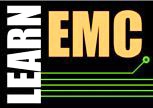EMC Question of the Week: April 10, 2023

When a single-ended signal drives a wire with no return conductor, the worst-case radiated emissions are well over the limit. Adding a current-return wire and a matched termination would reduce the worst-case emissions by about
- 0 dB
- 6 dB
- 20 dB
- more than 20 dB
Answer
The best answer is “b.” In the first configuration with no return conductor, the signal voltage drives a resonant monopole or dipole antenna. (The antenna is the wire being driven relative to the board and/or chassis.) In the second configuration, the signal voltage drives a matched transmission line. However, because an unbalanced source is driving a matched transmission line, there is a common-mode voltage driving the transmission line relative to the board and/or chassis. The amplitude of the common-mode voltage is half the signal voltage. In both cases, the antenna structure is nearly the same, but the voltage driving the antenna structure is a factor of 2 (6 dB) lower with the return conductor.
It's important that the question specified the worst-case emissions rather than the actual measured or simulated emissions. That's because the antenna formed by the twisted wire pair could have a slightly different resonant frequency than the single wire. If one configuration were driven precisely at its resonant frequency and the other driven slightly off resonance, the results would be different. Adding the return conductor could either increase or decrease the emissions. That's why it can be dangerous to rely on a single measurement or simulation to make design decisions.
It's also important to note that the 6-dB reduction assumed that the signal voltage did not change due to the loading of the matched termination or the antenna radiation impedance. A matched twisted wire pair would have a resistance of about 100 Ω, and a monopole radiation resistance would be at least 36 Ω. So for source impedances on the order of a few ohms, this is a reasonable assumption.
Have a comment or question regarding this solution? We'd like to hear from you. Email us at
